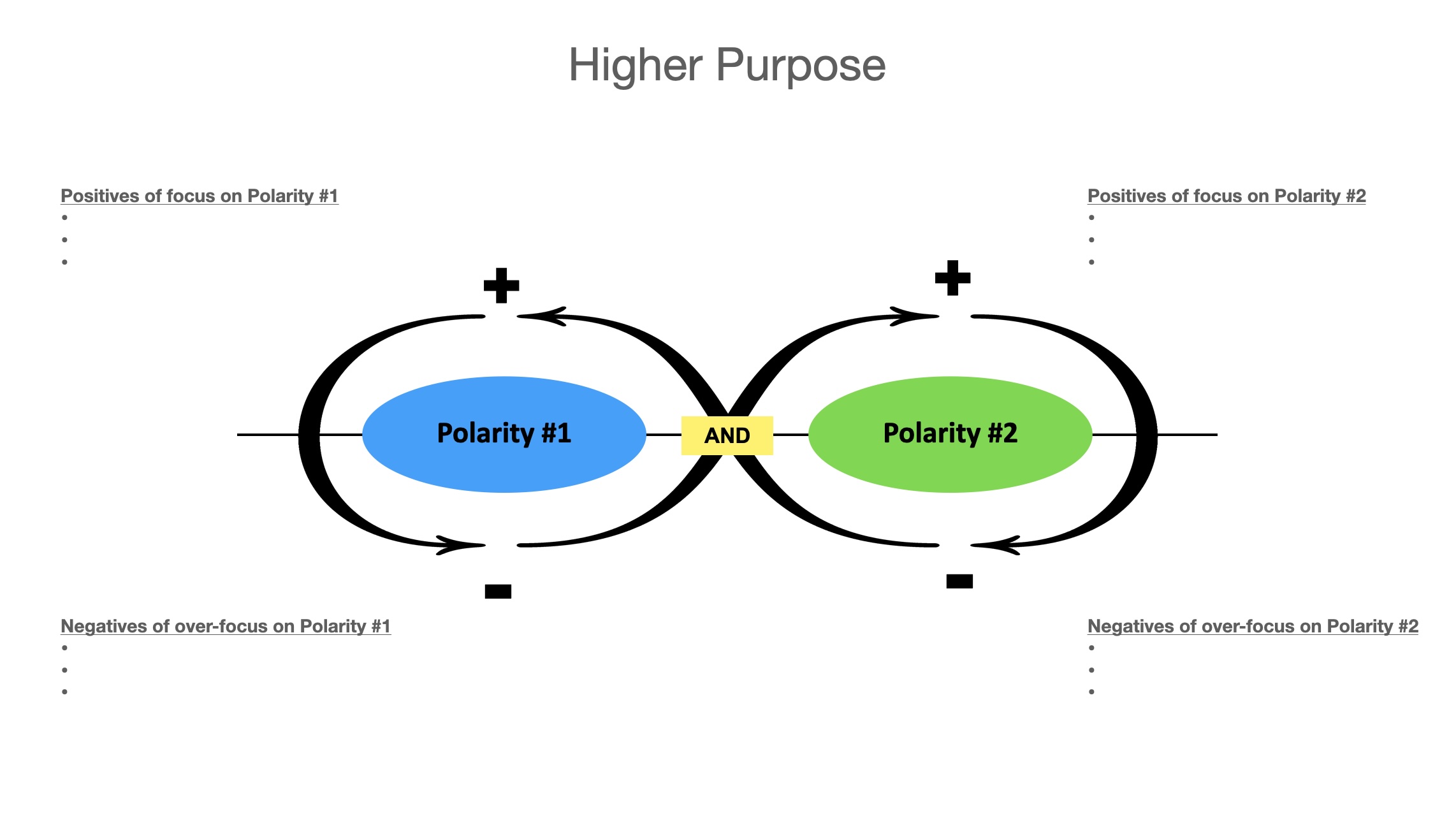This article is part of a series called, Surface Tension. The introduction article contains links to all other articles.
As leaders progress in their careers, they encounter a paradoxical reality: their problems become less solvable. Not because they lack skills or resources, but because they face polarities rather than problems.
Problems have solutions—clear endpoints where the issue is resolved. Polarities, by contrast, are ongoing tensions where both poles contain partial truths and essential benefits. They don't resolve; they require continuous navigation.
This distinction explains why so many organisational initiatives fail. Leaders apply problem-solving approaches to polarities, temporarily emphasising one pole at the expense of the other—only to watch the pendulum inevitably swing back.
Consider these common leadership tensions:
- Centralisation vs Decentralisation
- Short-term vs Long-term focus
- Innovation vs Efficiency
- Quality vs Speed
- Profitability vs Growth
These aren't choices to be made once and for all but dynamic tensions requiring ongoing attention to both poles. When treated as simple problems with single answers, they create the illusion of progress while setting up future failure.
The Polarity Map: A Tool for Navigating Tensions
Barry Johnson's Polarity Management framework offers a sophisticated approach to these challenges. Instead of framing polarities as either/or choices, it recognises them as both/and tensions requiring ongoing management.

The key insight is mapping both sides of a polarity to reveal their interdependence:
- The positive outcomes of focusing on Polarity #1
- The negative outcomes of over-focusing on Polarity #1
- The positive outcomes of focusing on Polarity #2
- The negative outcomes of over-focusing on Polarity #2
This mapping reveals how each pole's strengths and weaknesses create a natural cycle. Over-focus on one pole eventually produces its downsides, creating pressure to shift toward the other pole.
For example, reconciling short-term demands with long-term thinking might reveal the following polarity.

The truth is that organisations need both poles. They need to satisfy the demands of the short term while keeping an eye on the long term. They need to address and resolve both long-term and short-term issues. Choosing one over the other is not a viable solution.
Polarity Thinking in Action: Navigating Global–Local Tensions
Leading multinationals navigate the tension between global efficiency and local relevance through deliberate both/and strategies.
Coca-Cola delivers a globally consistent core product but adapts flavours, packaging, and advertising to local tastes—for example, sweeter recipes in India or regionally themed campaigns during Ramadan.
Apple standardises its product design and supply chain while tailoring customer service and marketing to local norms and languages.
Lenovo centralises R&D and manufacturing to drive efficiency but decentralises sales and support to reflect regional expectations and regulatory differences.
Banco Santander restructured its operations to grant autonomy to markets like Brazil, balancing local agility with global group alignment.
Johnson & Johnson , operating across more than 60 countries, uses a federated structure—combining global coordination with strong local operating companies. This allows responsiveness to diverse healthcare systems while leveraging centralised R&D and supply chain capabilities.
These companies don’t try to resolve the polarity—they manage it continuously, using structure, metrics, and culture to adjust emphasis as context evolves.
Microsoft's Cloud Transformation: A Polarity Success Story
Similarly, Microsoft's transformation under Satya Nadella illustrates this principle. Rather than choosing between its traditional on-premise software business and cloud services, Nadella reframed this as a polarity to manage.
Previous CEO Steve Ballmer had positioned this as an either/or choice, creating internal resistance from teams fearing that cloud would cannibalise existing revenue. Nadella recognised that Microsoft needed both—traditional products generating current revenue and cloud services securing future growth.
By mapping the polarity explicitly, Microsoft could:
- Continue supporting existing on-premise customers while investing in cloud infrastructure
- Use traditional software profits to fund cloud innovation
- Gradually migrate customers at their own pace rather than forcing an abrupt switch
- Leverage existing relationships to build cloud adoption
This both/and approach allowed Microsoft to support existing customers while building a market-leading cloud platform, delivering record financial results that previous either/or thinking had made impossible.
The Psychological Power of Polarity Thinking
What makes polarity thinking psychologically sophisticated is its acknowledgment that tensions cannot be permanently resolved. This shifts leaders from the false promise of final solutions to the realistic practice of ongoing management.
When treating polarities as problems to solve, organisations typically:
- Pick a pole (often swinging from the previously neglected one)
- Implement it as "the answer"
- Eventually experience its downsides
- Swing back to the other pole, dismissing the previous approach as "wrong"
- Repeat the cycle indefinitely
This oscillation creates initiative fatigue, cynicism, and wasted resources as organisations repeatedly dismantle yesterday's solution to implement today's—only to reverse course tomorrow.
Polarity thinking breaks this pattern by:
- Legitimising both perspectives rather than pitting them against each other
- Reducing unnecessary conflict by acknowledging complementary truths
- Creating early warning systems for over-focus on either pole
- Building adaptive capacity to shift emphasis as conditions change
As one senior executive noted: "Once we mapped our key polarities, the most heated arguments in our leadership team simply disappeared. People who had been battling for years suddenly realised they were both right—just emphasising different aspects of the same polarity."
Implementation Insight: Mapping Your First Polarity
Identify one persistent tension in your organisation where people take opposing sides. Rather than trying to resolve it, map it as a polarity (use this template in Powerpoint , Keynote or Google Slides ), showing the positives of focusing on each pole and, similarly, the limitations of over-focus. This reframing often immediately reduces conflict and opens space for more sophisticated solutions.
